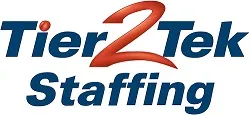Staffing Industry Terms

Welcome to the Tier2Tek Dictionary—a comprehensive resource for key terms and definitions in the staffing and recruitment industry. Whether you’re looking to understand specific hiring terminology or gain insight into our process, this page serves as a quick reference to help you navigate the language of talent acquisition with ease.
Applicant Tracking System (ATS)
A software application used by recruiting firms and HR departments to streamline the recruitment process by managing job applications, tracking candidates, and storing resumes.
Background Check
The process of investigating a candidate’s history, including criminal records, employment verification, and education, to confirm their suitability for a role.
Candidate Experience
The overall perception a job seeker has about a company’s hiring process, from initial application to final onboarding.
Candidate Sourcing
The process of identifying and attracting potential candidates for a specific job position, often before the application stage.
Career Development
The ongoing process of learning, training, and growth that helps employees enhance their skills, advance their careers, and reach professional goals.
Compensation
The total amount of salary, benefits, bonuses, and other monetary or non-monetary rewards given to employees in exchange for their work.
Contingent Workforce
A labor pool consisting of workers who are hired on a temporary, contract, or freelance basis instead of being full-time employees.
Direct Hire Staffing
A recruitment solution where the staffing agency helps a company find permanent employees who are hired directly by the company.
Employee Relations
The management of relationships between employers and employees, focused on resolving issues and promoting a positive work environment.
Employee Retention
Strategies and practices aimed at keeping valuable employees within an organization to reduce turnover.
Exempt vs Non-Exempt Employees
A classification system that determines whether an employee is eligible for overtime pay (non-exempt) or exempt from it based on job duties and salary level.
Executive Search
A specialized recruitment service used to source candidates for senior-level and executive positions.
Flexible Work Arrangements
Workplace policies that allow employees to have flexibility in their work schedules, locations, or hours, such as remote work or flextime.
Full-Cycle Recruiting
The end-to-end process of recruiting, which includes everything from sourcing candidates to onboarding them into the company.
Headhunting
A recruitment approach focused on identifying and pursuing highly qualified candidates, often for executive or specialized positions.
High-Volume Hiring
Recruiting strategy for filling a large number of positions within a limited timeframe, typically used during expansion or peak business seasons.
Hiring Manager
A person within a company responsible for the hiring process, typically leading interviews, making hiring decisions, and collaborating with the HR team.
Hiring Process Steps
The structured approach to finding, interviewing, selecting, and onboarding new employees. Steps typically include job posting, sourcing, interviewing, and onboarding.
Interviewing
The process of conducting a structured conversation with a candidate to evaluate their suitability for a job position.
Job Description
A written statement that outlines the duties, responsibilities, required qualifications, and reporting structure for a specific job position.
Job Offer Letter Template
A standardized format for an official letter provided by employers to a candidate who has been selected for a position, outlining job details, salary, and terms of employment.
Job Posting
An announcement that a job opening is available within a company, typically including a job description, responsibilities, qualifications, and application instructions.
Onboarding
The process of integrating a new employee into the organization, which includes orientation, training, and acclimatization to the company culture.
Passive Candidate
An individual who is not actively seeking a job but may be open to new opportunities if approached.
Performance Review
A formal assessment in which an employer evaluates an employee’s job performance, skills, achievements, and growth opportunities.
Permanent Placement
A staffing service where the agency finds and places candidates in permanent roles within a company, typically involving a direct hire agreement.
Recruiter
A professional responsible for sourcing, screening, and interviewing candidates for job positions, often working within a staffing agency or as part of a company’s HR team.
Recruitment
The overall process of finding, attracting, interviewing, and hiring employees for an organization.
Recruitment Marketing
The strategies and tactics used to promote the value of working for a company and attract top talent.
Reference Check
The process of contacting a candidate’s previous employers or colleagues to verify employment history, skills, and character as part of the hiring process.
Retention Rate
A metric that indicates the percentage of employees who remain employed at a company over a specific period of time.
Skills Gap
The difference between the skills required for a job and the actual skills possessed by the workforce or candidates.
Sourcing
The practice of finding and attracting potential candidates for job openings, typically using platforms like LinkedIn, job boards, and networking events.
Staffing Agency
An organization that matches companies with potential candidates to fill job openings, often specializing in specific industries or job types.
Talent Acquisition
The strategic approach to identifying, attracting, and onboarding top talent to meet a company’s hiring needs.
Talent Pipeline
A database of candidates who are qualified and ready to fill open positions as soon as they become available.
Technical Recruiting
A specialized form of recruiting focused on sourcing, evaluating, and hiring candidates for technical and IT positions.
Temporary Staffing
The process of hiring employees for a short-term period to meet business needs, such as seasonal demand or special projects.
Temporary-to-Permanent Staffing
A hiring arrangement where an employee starts as a temporary worker and, based on performance, may be transitioned to a permanent role.
Temp Agency
A staffing firm that provides temporary workers to businesses, often for short-term projects or to fill in for absent employees.
Workforce Planning
A strategic process used by organizations to forecast current and future staffing needs and develop plans to meet those needs.
